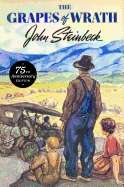The Grapes of Wrath (75th Anniversary Edition)

Editorial Viking USA
Fecha de edición abril 2014 · Edición nº 1
Idioma inglés
EAN 9780670016907
496 páginas
Libro
encuadernado en tapa dura
Resumen del libro
April 2014 marks the 75th anniversary of the first Viking hardcover publication of Steinbeck's crowning literary achievement.
First published in 1939, Steinbeck's Pulitzer Prize-winning epic of the Great Depression chronicles the Dust Bowl migration of the 1930s and tells the story of one Oklahoma farm family, the Joads, driven from their homestead and forced to travel west to the promised land of California. Out of their trials and their repeated collisions against the hard realities of an America divided into haves and have-nots evolves a drama that is intensely human yet majestic in its scale and moral vision, elemental yet plainspoken, tragic but ultimately stirring in its human dignity.
A portrait of the conflict between the powerful and the powerless, of one man's fierce reaction to injustice, and of one woman's stoical strength, the novel captures the horrors of the Great Depression and probes the very nature of equality and justice in America. As Don DeLillo has claimed, Steinbeck "shaped a geography of conscience" with this novel where "there is something at stake in every sentence." Beyond that--for emotional urgency, evocative power, sustained impact, prophetic reach, and continued controversy--"The Grapes of Wrath "is perhaps the most American of American classics.
To commemorate the book's 75th anniversary, this volume is modeled on the first edition, featuring the original cover illustration by Elmer Hader and specially designed endpapers by Michael Schwab.
Biografía del autor
Narrador y dramaturgo estadounidense (Salinas, 1902 - Nueva York,1968) famoso por sus novelas que lo sitúan en la primera línea de la corriente naturalista o del realismo social americano y muy próximo a la crónica periodística. Su estilo se caracteriza,sin embargo, por tener una gran carga de emotividad tanto por sus argumentos como en el simbolismo que trasuntan en situaciones y personajes que crea, como ocurre en sus obras mayores: De ratones y hombres (1937), Las uvas de la ira (1939) y Al este del Edén (1952). Obtuvo el premio Nobel en 1962.








